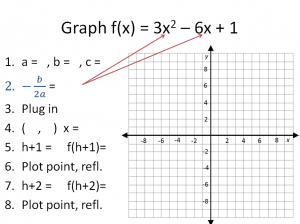


And we got it right.A quadratic polynomial with two real roots (crossings of the x axis) and hence no complex roots. So first I'll do the vertexĪt 2 comma negative 5, which is right there. For example, x2 x+1 0 x 2 x + 1 0 can be written as the. The form ax2+bx+c 0 a x 2 + b x + c 0 is called the standard form of the quadratic equation. Which is equal to- let's see, this is equal to 2 squared is 4. A quadratic equation is an equation of the form ax2+bx+c 0, a x 2 + b x + c 0, where a 0.
#Quadratic standard form plus
When x equals 2, y is going toīe equal to 5 times 2 squared minus 20 times 2 plus 15, Before solving a quadratic equation using the Quadratic Formula, its vital that. To substitute back in to figure out its y-coordinate. The form ax2 + bx + c 0 is called standard form of a quadratic equation. Sits exactly smack dab between the roots, I want to figure out, is this point right This is true, and you canĪdd 3 to both sides of this. And so this will be true ifĮither one of these is 0. X's will make this expression 0, and if they make Side, we still have that being equal to 0. On factoring quadratics if this is not so fresh- isĪ negative 3 and negative 1 seem to work. And whose sum is negativeĤ, which tells you well they both must be negative. Whose product is positive 3? The fact that their And now we can attempt toįactor this left-hand side. Plus 15 over 5 is 3 isĮqual to 0 over 5 is just 0. Me- these cancel out and I'm left with x squared The x squared term that's not a 1, is to see if I canĭivide everything by that term to try to simplify I like to do whenever I see a coefficient out here on We're going to try to solve the equation 5x Those three points then I should be all set with And then I also want toįigure out the point exactly in between, which is the vertex. This equation is called 'quadratic' as its degree is 2 because 'quad' means 'square'. Minus 20x plus 15, when does this equal 0? So I want to figure The standard form of quadratic equation is ax2 + bx + c 0, where 'a' is the leading coefficient and it is a non-zero real number. Seen, intersecting the x-axis is the same thingĪs saying when it does this when does y equal I want to first figure out whereĭoes this parabola intersect the x-axis. You can just take threeĬorresponding values for y are and just graph The following equation y equals 5x squared

Therefore, 3 and 1 are the only possible x values. So -3 doesn't work as an x, and the same thing would happen with -1:īoth of these solved binomial equations show that -3 and -1 cannot be x values for the parabola. X cannot equal -3 or -1 because if x was -3 then this would happen: The reason that Sal made the x values positive 3 and 1 is because they are the only two x values that would make his equation equal zero.
#Quadratic standard form how to
(this basically explains how to get the 3 and 1 for the x values and it explains why -3 and -1 do not work for x values.) I think that was the question you were asking, I hope that helped, if not, hopefully this will: you can check them out if you are still confused. The -3 and -1 were not x values, they were just what he used to factor in a way that he teaches in previous factoring videos.

In order to find the x values he used that binomial and made it equal 0, and his x values that he found were 3 and 1. the -3 and -1 were numbers that he got when he factored the equation into a binomial. the -3 and the -1 that he got were not his x values. He didn't exactly switch his x values to positive.


 0 kommentar(er)
0 kommentar(er)
